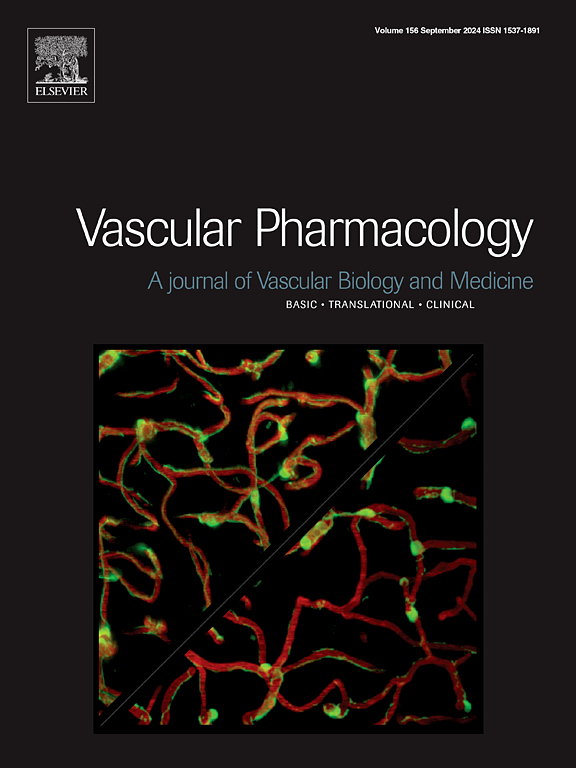双L/T钙通道阻滞剂在L- name诱导的高血压模型中具有降压和肾保护作用。
IF 3.5
3区 医学
Q2 PHARMACOLOGY & PHARMACY
引用次数: 0
摘要
肾性高血压是一种常见的继发性高血压,由肾脏疾病引起。它是由连接肾脏的动脉狭窄引起的,通常是由动脉粥样硬化引起的。随着时间的推移,这种情况会导致肾衰竭。目前保护肾脏的治疗方法有限,这促使人们在高血压的背景下不断寻找新的肾脏保护药物。与选择性钙通道阻滞剂相比,双重阻断l型和t型钙通道在治疗高血压方面显示出希望。已证实totaculin是t型通道的有效抑制剂。采用保守氨基酸序列比较、电生理记录和Flex Station等方法,评价和比较了totaculin对HEK293T细胞瞬时表达的CaV3.1和CaV1.2通道及其残基的影响。使用分子探针fluo-4-AM评估细胞内Ca2+。他们专门研究了totaculin对血管平滑肌细胞(VSMCs)的影响。利用从器官浴系统中分离的大鼠主动脉环来评估totaculin的致肌作用。在体内环境下,采用l - name诱导的小鼠高血压模型来研究托达库林的抗高血压和肾保护作用。我们发现CaV1.2中的L1047A和CaV3.1中的L1456A是toddaculin潜在的关键结合位点,并且toddaculin对CaV3.1和CaV1.2的抑制作用相同且呈剂量依赖性。在激光扫描共聚焦显微镜下,totaculin诱导的VSMCs [Ca2+]下降。暴露于totaculin的主动脉环在kcl诱导的收缩后表现出剂量依赖性松弛。此外,在l - name诱导的小鼠肾损伤中,丁香碱具有显著的降血压和保护肾的作用。这一发现提供了一个明显的治疗潜力,作为抗高血压候选药物与肾保护作用。本文章由计算机程序翻译,如有差异,请以英文原文为准。

Dual L/T calcium channel blocker exerts both antihypertensive and renoprotective effects in L-NAME-induced hypertension model
Renal hypertension, a common form of secondary hypertension, results from kidney disease. It arises due to the narrowing of arteries connected to the kidneys, often caused by atherosclerosis. Over time, this condition can lead to kidney failure. Therapeutics for kidney protection are currently limited, prompting continual search for new renoprotective agents in the context of hypertension. Dual blockage of both L-type and T-type calcium channels has shown promise in the treatment of hypertension when compared to selective calcium channel blockers. Toddaculin has been proven to be a potent inhibitor of the T-type channel. Conserved amino acid sequence comparison, electrophysiological recordings, and Flex Station were used to evaluate and compare toddaculin effect on the CaV3.1 and CaV1.2 channels and their respective residues, transiently expressed in HEK293T cells. Intracellular Ca2+ was assessed using the molecular probe fluo-4-AM. They specifically investigated the impact of toddaculin on vascular smooth muscle cells (VSMCs). Toddaculin's myogenic effects were assessed using aortic rings isolated from rats within an organ bath system. In an in vivo context, a mouse model with L-NAME-induced hypertension was employed to investigate toddaculin's anti-hypertensive and renoprotective properties. We found that L1047A in CaV1.2, and L1456A in CaV3.1 are potential key binding sites for toddaculin, and that toddaculin inhibited CaV3.1 and CaV1.2 equally and dose-dependently. Toddaculin-induced decline of [Ca2+]i cultured VSMCs under a laser scanning confocal microscopy. Aortic rings exposed to toddaculin demonstrated dose-dependent relaxation following KCl-induced contraction. Moreover, toddaculin exhibited significant blood pressure reduction and renoprotective effects against L-NAME-induced renal injury in mice. This finding provides an evident therapeutic potential of toddaculin as an antihypertensive drug candidate with a renoprotective effect.
求助全文
通过发布文献求助,成功后即可免费获取论文全文。
去求助
来源期刊

Vascular pharmacology
医学-药学
CiteScore
6.60
自引率
2.50%
发文量
153
审稿时长
31 days
期刊介绍:
Vascular Pharmacology publishes papers, which contains results of all aspects of biology and pharmacology of the vascular system.
Papers are encouraged in basic, translational and clinical aspects of Vascular Biology and Pharmacology, utilizing approaches ranging from molecular biology to integrative physiology. All papers are in English.
The Journal publishes review articles which include vascular aspects of thrombosis, inflammation, cell signalling, atherosclerosis, and lipid metabolism.
 求助内容:
求助内容: 应助结果提醒方式:
应助结果提醒方式:


